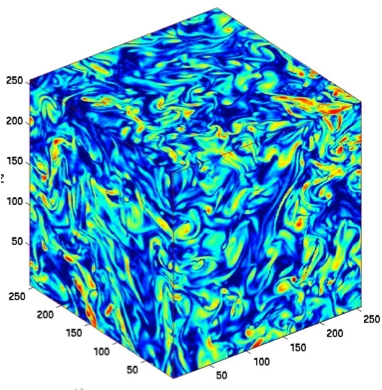A Return to First Principles in Large-Eddy Simulation
Since turbulence is created by advection, why model it with an artificial viscous stress? Instead, the nLES method uses the first-ever advective closure in large-eddy simulation to model precisely the unresolved scales in turbulent flows.

Overview: A Fundamental Paradigm Shift
Numerous applications in the engineering, environmental and physical sciences involve phenomena in which multiple physical processes are tightly coupled to turbulent flow. For example, turbulent plumes arising from industrial fires, weapon detonations, smokestacks, rivers, geysers and volcanoes, all involve turbulence transporting passive scalars like dust, soot and silt. Similarly, the turbulence mixing fuel and oxidizer in jet, rocket and internal combustion engines directly impacts the efficiency, durability and safety of engine operation. There is thus great interest in studying these and other turbulent phenomena via numerical simulation. However, advective processes within the turbulence generate an enormous range of time and length scales, making fully resolved simulations of most turbulent flows impractical for the foreseeable future. Therefore, numerical studies of such flows must remain under-resolved, with a subgrid model used to represent the missing scales. Unfortunately, most subgrid models are based on artificial viscosity or numerical dissipation constructs and are significantly inaccurate, since they introduce a viscous or dissipative stress where none exists in the physical system. In large part because of this, such models are widely recognized as fundamental roadblocks to the higher-fidelity numerical study of most turbulent flows.
In this light, significantly higher simulation fidelity can be obtained with the the Nonlinear LES (nLES) method. The nLES method embodies a fundamental paradigm shift in turbulence modeling, in that the traditional use of the artificial-viscosity construct in subgrid modeling is replaced by the direct solution of the nonlinear terms in the filtered Navier-Stokes and advection-diffusion equations. By closing the filtered (u_i u_j) and (u_j φ) terms in their original forms, as nonlinear advective stresses rather than by adding a linear viscous stress, the nLES method thus represents a “return-to-first-principles” in turbulence simulation. This paradigm shift is made possible in part by applying recent advances in the area of multifractal formalism, a discipline related to chaos and dynamical systems theory. At least two groundbreaking capabilities arise directly from this paradigm shift. First, nLES is the only method that can capture with extremely high correlations ( ρ > 0.99 ) the local two-way structure of turbulent momentum and energy exchange in an LES. Second, because it applies no artificial viscous stresses, the nLES method can recover small-scale flow dynamics with significantly higher fidelity than traditional methods. Both of these are essential for the accurate study of multiphysics systems involving turbulent flow. Several studies have already used the nLES method to obtain one-of-a-king results with significantly heightened fidelity, including (i) the first-ever LES studies of high Schmidt-number turbulent mixing, (ii) the significantly improved simulation of a variable-density turbulent plume, and (iii) the first-ever simulation of ultra-high Atwood number ( A ≥ 0.90 ) Rayleigh-Taylor flow. The present TASC website also discusses a range of other applications that are now being studied, many for the first time, with the enhanced capability of the nLES method.

The History of the nLES method
The nLES Method is based on an original idea of multifractal-based modeling of the subgrid scales in a large-eddy simulation first proposed by Professor Werner J. A. Dahm of the Department of Aerospace Engineering at the University of Michigan, Ann Arbor, and developed by Burton and Dahm. In a series of ground-breaking studies, Dahm had previously demonstrated that gradient-squared fields in turbulent flows, such as kinetic-energy dissipation, scalar-energy dissipation and enstrophy (the square of the vorticity magnitude), exhibit scale-invariant multifractal structure at inertial-range scales. That is, the spatial distribution of these fields does not change as they are examined at various scales within the flow. This structure can be rigorously described with multifractal formalism, developed by Mandelbrot and others since the 1970's in the fields of chaos and nonlinear dynamical systems theory. Based on this, Dahm recognized that, using the Biot-Savart operator (which relates the vorticity field to the velocity field), one could use the multifractal structure of the enstrophy field to recover the structure of the velocity field at any given scale range. In this way, the subgrid enstrophy field could then be used to construct a subgrid velocity field that, in turn, could be used in large-eddy simulations of turbulent flows. More coming soon.

Subsequent Work
Coming Soon.

Subsequent Work
Coming Soon.




